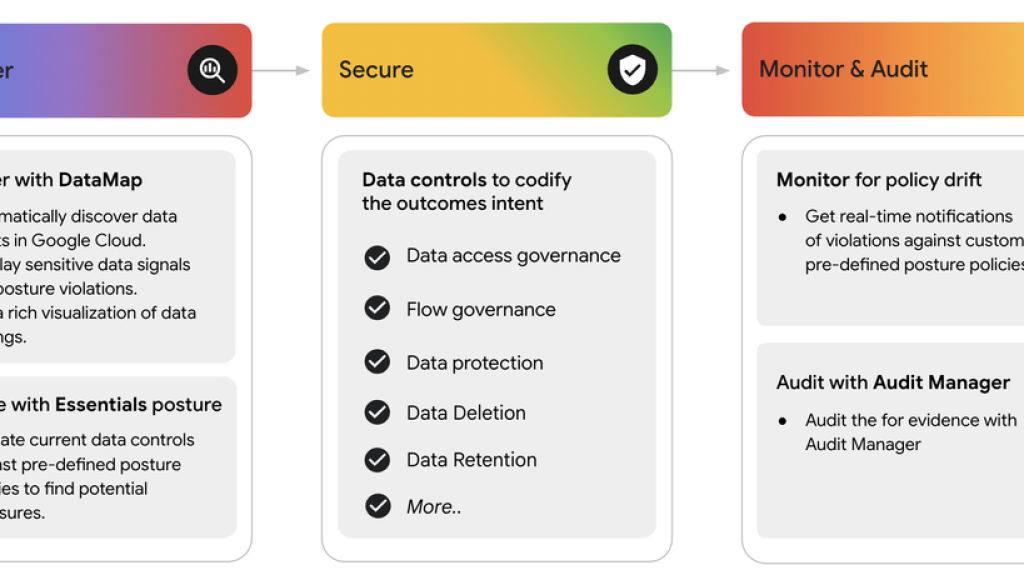GCP – Going beyond basic data security with Google Cloud DSPM
In the age of data democratization and generative AI, the way organizations handle data has changed dramatically. This evolution creates opportunities — and security risks. The challenge for security teams isn’t just about protecting data; it’s about scaling security and compliance to meet this new reality.
While traditional security controls are vital to risk mitigation, many data security posture management solutions lack the necessary capabilities that today’s organizations require. For example, an organization with AI workloads needs to make sure that sensitive data is not leaking into the training environment; that intellectual property such as models and weights are protected from exfiltration; and that all their models support “compliance explainability.”
There are four key concerns that organizations should understand for robust data security: where sensitive data resides, how it’s used, what controls can secure it, and the monitoring tools available to provide evidence for compliance. Our new Data Security Posture Management (DSPM) offering, now in preview, provides end-to-end governance for data security, privacy, and compliance.
DSPM capabilities include differentiating advanced data controls that match security, privacy, and compliance requirements and align with business needs. Available as part of Security Command Center, this Google Cloud-native solution can help reduce tooling complexity, and provides native platform experience.
- aside_block
- <ListValue: [StructValue([(‘title’, ‘$300 in free credit to try Google Cloud security products’), (‘body’, <wagtail.rich_text.RichText object at 0x3e997b6f5280>), (‘btn_text’, ”), (‘href’, ”), (‘image’, None)])]>
DSPM starts with a data map that offers a birds-eye view of data across your Google Cloud environment, its sensitivity level, and its default security posture. Discovery can help apply policies to monitor and secure their data, allowing curated controls to be matched with their sensitive data needs.
With Google Cloud DSPM, security and compliance teams can:
-
Discover data: DSPM provides comprehensive visibility into your data estate. It automatically discovers data assets across your Google Cloud environment and uses sensitivity labels from Sensitive Data Protection to help you understand what data you have and where it resides.
-
Assess risk: DSPM evaluates your current data security posture against Google Cloud’s recommended best practices, and can help identify potential vulnerabilities and misconfigurations.
-
Protect data: DSPM deploys data security frameworks by mapping security and compliance requirements to control policies, and can help you monitor them in near-real time.
-
Simplify compliance: DSPM can audit data against relevant compliance frameworks, help you pinpoint gaps, and generate detailed, evidence-backed compliance reports. DSPM can also help assess compliance with HIPAA, GDPR, and PCI DSS.
A visual overview of Google Cloud’s Data Security Posture Management solution.
How advanced DSPM controls help with security and compliance requirements
Security teams can get started by identifying sensitive data in their organization’s Google Cloud environment, and mapping desired security and compliance outcomes to specific data controls. To make this process easier, DSPM offers advanced controls, such as data access governance, flow governance, data protection, and data deletion controls to meet security and compliance outcomes.
Currently, these controls can be applied in detective mode on data boundaries, including organization, folder, and project. You can also use Google Cloud Sensitive Data Protection (SDP) to scan for specific types of sensitive data.
Applying advanced data controls to protect data.
Data access governance
Using data access governance control, you can govern access to sensitive data, and restrict access in detective mode, to approved principals.
For example, an organization that needs governance around customer billing data can create a policy to allow only the fraud detection team to access sensitive customer billing information, and apply that control policy across sensitive data. Once applied, the policy will follow the data and surface any non-compliant access events.
Flow governance
Using data flow control, you can restrict how data is moved across country boundaries in detective mode, to ensure that sensitive customer data is not moved outside a country boundary. As an example, let’s consider an organization with operations in a specific country that has a compliance requirement to not move customer data outside the country’s geographic boundary. With data flow governance, the organization can create a policy to only allow flow of data within that country, and apply that policy to sensitive data. Once applied, the control will surface any non-compliant read operations from outside the allowed geographic boundary.
Data protection
Data protection controls can help manage the encryption key configuration, such as enforcing customer managed encryption keys (CMEK). You can create a policy to enforce CMEK as a policy on the keys protecting sensitive data.
Data deletion
Using data deletion controls, you can manage the maximum duration that the data will be retained. You can create a policy with an allowed maximum retention period, and apply it to sensitive data.
Help shape the future of data security
We’re inviting security and compliance teams to be among the first to experience the power of Google Cloud DSPM. As part of the DSPM preview, organizations can:
-
Activate DSPM and begin evaluating its capabilities for specific business needs. For a detailed guide, please refer to the user guide.
-
Join the Technical Advisory Council and Customer Design Panels to provide valuable feedback that can influence DSPM development.
-
Work with Google Cloud experts to optimize their data security strategy and ensure a successful implementation.
For further questions, contact your Google Cloud account team, or or send us your feedback at dspm-pm@google.com.
Read More for the details.



